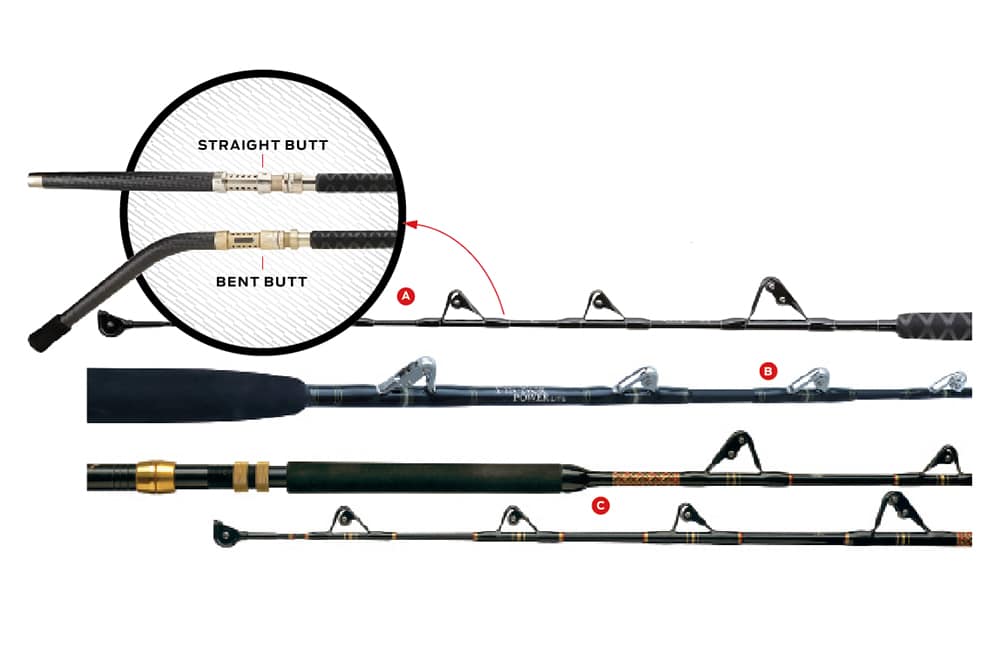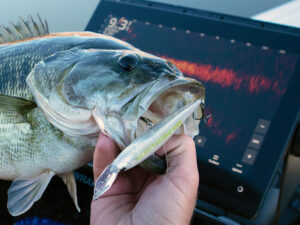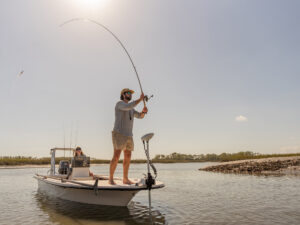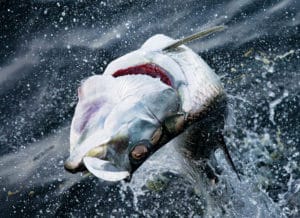
Stand-Up Sticks for Yellowfin Tuna
Big tuna, big stick? No, you don’t need a heavy, solid‑fiberglass stand-up rod to fight big yellowfin or bluefin tuna anymore — not since the latest advancements in build materials.
No doubt, all-fiberglass rods are extremely durable, so much so that some anglers may never put down their favorite tuna fishing rods. Popular examples include Penn International V stand-ups, Calstar West Coast series, Star Aerials and others, though it’s important to note that some of these glass rods utilize hollow or tubular construction.
But with 50- to 80-pound-class conventional reels getting smaller, and the diameter of braided super lines shrinking, it’s not surprising that stand-up conventional sticks — tuna rods that you might have to clutch for long battles — are losing weight and gaining action. Some of the best tuna fishing rods available today might also be some of the lightest in weight.

Tuna Fishing Rod Construction
Over the past decade, composite rods have been taking over. Fiberglass- and-graphite construction rods produce the strength of fiberglass, plus the sensitivity of graphite, says Mike Whitman, director of marketing for Fin-Nor rods. All-glass rods tend to be less sensitive and much heavier when compared with composites, he says.
Fishing rod manufacturers use confusing terminology to explain one part of the composite mix. “We say graphite rods, but it’s really carbon fiber,” says Chris Cathart, Penn’s lead rod engineer. “The two terms are often used interchangeably.”
Graphite and carbon fiber are both produced from carbon, but graphite is carbon atoms arranged as hexagonal rings and layered, while carbon fiber is a chain of carbon atoms. Carbon fiber helps produce a smaller-diameter sensitive blank with better action.
“With older fiberglass rods, the mono main line stretched and afforded the angler some give when fighting a fish,” says Cathart. “Today’s braid super lines don’t have the stretch, so increased action in the rod is necessary.”
Top tuna fishing rod manufacturers produce stand-up conventional rods with a composite mix of graphite and glass, including Fin-Nor’s Tidal PowerLite, Penn’s Bluewater Carnage and Shimano’s Terez. “The graphite in the rod keeps the overall weight down, while the glass gives it durability,” says Shimano product manager Robby Gant. “A slight high-stick with a rod with too much graphite and it explodes, while too much glass and you’re fishing with a rod that’s too heavy.”
Cathart did a comparison between Penn rods made of 100 percent fiberglass and others with carbon-glass composite to find that weight differences total as much as 20 percent, depending on the rod model.

Characteristics of the Best Tuna Fishing Rods
Layered construction in rod blanks means that yellowfin and bluefin tuna rods no longer have to resemble a broomstick. Shimano’s TC4 process creates a thick rod wall but still produces a slim diameter by utilizing two inner layers of T-glass and an inner and outer layer of carbon.
“Let’s say you are holding a 6-foot steel rod like you’re pulling on a fish,” says Gant. “Anyone, even a kid, can grab the end of the steel rod and yank you around — that’s equal to a fish winning the battle. Some anglers feel like if they aren’t getting beat up, then they aren’t putting enough pressure on the tuna — that just isn’t true.”
Rod actions are lighter and faster than in the past, says Whitman, but it’s parabolic action rather than fast-tip action. Parabolic action refers to the characteristic of a rod to bend down toward your hands while fishing — this ability leverages more pressure on a tuna from your tuna fishing setup.
Length of the rod also has an effect on its action.
“All Fin-Nor [boat] rods are at least 6 feet, 10 inches,” says Whitman. “The only difference is in the power of the blank. This rod length allows the angler to cast the bait rather than just use it for conventional trolling.”
In the Pacific, long-range fishermen use rods over 7 feet to clear the corners of the boat when pulling on a fish. These types of boats incorporate high rails; many anglers place the foregrip on the rail, in essence making the rod shorter and easier to pull on fish.
To really clamp down on a massive tuna, a shorter rod helps, so pick your tuna fishing gear wisely.
“When fishing big tuna in the Gulf of Mexico out of a center-console, a shorter rod from 5 feet, 6 inches to 6 feet is perfect,” says Gant. “You get enough length to clear the outboards, and the shorter rod really lends itself to pulling with maximum force on a fish stand-up style.”

Tuna Fishing Rod Hardware
Aside from the blank itself, a rod’s hardware makes a difference. No matter what, make sure your main line slides cleanly through the guides. “Quality guides on rods these days really don’t fail, however the wrapping on those guides is key,” says Gant. “A double- or triple-wrapped guide better withstands the strain of a tuna year after year.”
I asked Sean Cheaney, at Mudhole Custom Tackle, about his ideal big-tuna stand-up rod.
“A short, bent aluminum butt for leverage, 10- to 14-inch foregrip, and AFTCO HD roller guides and top, all paired to a 6-foot composite Calstar Grafighter blank in the 40- to 100-pound class,” he says. “On this style of rod, I wouldn’t waste my time with anything but an aluminum butt.”
Newer rods with aluminum reel seats and butts are fairly indestructible, plus the aluminum provides added strength. Even still, economically priced graphite reel seats have come a long way, and hold up well against yellowfin. “Yes, aluminum is a stronger material, but in all the years I’ve been building fishing rods, I have never seen a graphite seat fail,” says Gant.
For true stand-up tuna fishing, Shimano introduced new carbon butts — half the weight of aluminum but equal in strength, the company says — on Terez and Tallus rod models. “A Tiagra 50 with an all-roller rod and aluminum butt is 2 pounds heavier than a Talica 50 with the new Terez rod featuring a carbon butt,” says Gant.
But hardware isn’t the most common cause for rod failure; it’s usually misuse by the angler. “Grabbing past the foregrip, high-sticking the rod, or allowing the rod to smack the gunwale are the most common ways to break a rod,” says Cathart.
Don’t accidentally abuse the rod, especially when transporting it in the truck or the boat. Impact fractures that nick the graphite cause a weak point.
“I hear fishermen say, ‘I was just pulling on a small tuna, and the rod broke,’” says Gant. “Actually, that rod broke when it was smacked against the gunwale or bouncing around in your truck, but it separated when you were pulling on a fish.”
Compare Stand-Up Tuna Fishing Rods









